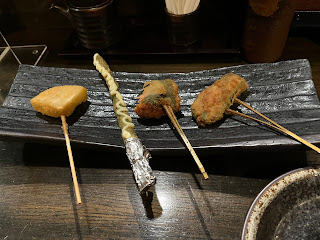Dassai - A Japanese sake
History and nomenclature
One of the finest sakes in Japan and worldwide, Dassai in Japanese literally means ‘otter festival’. The origin of this unique name lies in the history of Yamaguchi prefecture. It is said that otters gathered near a river to catch fishes and laid them along the banks to display their fishing skills! Asahi Shuzo tha manufacturer of Dassai has its home in Yamaguchi located in southwest of Honshu (main island).
Varieties
Traditional way to drink
An empty glass is placed inside a box like container called the Masu. The sake is poured until it overflows from the glass and fills up the Masu. Once you finish enjoying your first serving, you can help yourself with the second. This traditional way takes the experience of drinking sake to a whole new level.
Something to nibble?
When it comes to appetizers with sake, my personal favorite is kushiage (batter and bread crumps coated deep-fried skewered meat and vegetables) and cream cheese pickled in miso.
There are different types of sake and there is endless to talk on Japanese bars, cusine and culture in general. Check out ebunka for more fun stuff!




I love reading about different cultures, their food and to know different people. This was really insightful and a fun read.
ReplyDeleteLooks tasty! Any recommended bars?
ReplyDelete